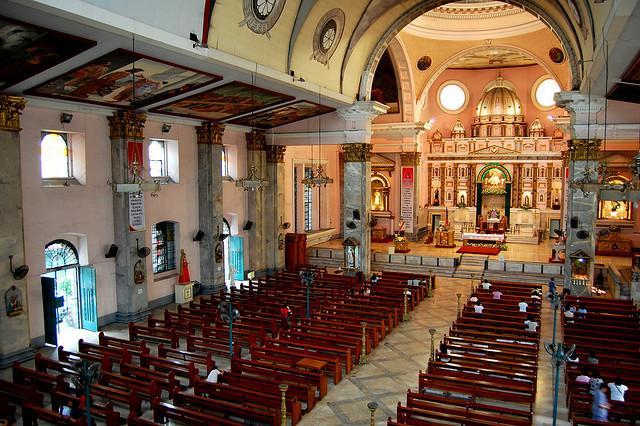
Founded by the Dominican priests in 1596, Binondo Church or Minor Basilica of St. Lorenzo Ruiz is one of the oldest places of Christian worship in the Philippines. It was administered by secular priests in 1768, returned to Dominican administration in 1822 and back to secular priests in 1898.
The maintenance is largely funded by the Catholic Chinese community, many of whom reside or operate businesses in neighboring Chinatown. Masses are held in Filipino, in Chinese dialects (Mandarin, Hokkien), and in English.
Patron Saint
Also known as the Minor Basilica of San Lorenzo Ruiz, Binondo church was named after the sacristan, San Lorenzo Ruiz, who was born of a Chinese father and a Filipino mother. He was trained in this church then went to Japan as a missionary, where he was executed for refusing to renounce his religion. He was canonized in 1989.
A large statue of the martyr stands in front of the church, being the first Filipino saint.
History
The hospitable attitude to the Chinese by the early Spanish colonists became an incentive for the former to increase their trade to Manila. Soon enough, there was an upsurge in their population. The difficulty came when the missionaries realized that aside from the natives, they had to manage the conversion of the Chinese population. This prompted the church headed by Bishop Domingo de Salazar to issue an appeal for the religious orders (there were three in the colony that time) to Christianize these pagans. But due to lack of personnel and difficulty in learning the Chinese language, the request was turned down.
The task of conversion fell to the Dominicans who arrived on July 21, 1587. Some of their first houses were built exclusively for the Chinese -- the Hospital of San Gabriel (Intramuros 1588 and Binondo, 1598); the church in Baybay (1588) between Tondo and Manila which was dedicated to Our Lady of Purificacion.
In 1596, Dominican priests founded Binondo church to serve their Chinese converts to Christianity as well as to the native Filipinos.
On December 7, 1923, the Sacred Consistorial Congregation transferred the ministry of the Chinese back to the Dominicans. But in view of the lack of a parish church, the Archbishop granted the use of the church for the material services of the Chinese community until a time that a church could built.
This kind of situation existed until it was put to an end in the last war. In 1945, the parish priest for the Chinese, Fr. Antonio Garcia, obtained permission to build a church and convent in the premises of the Binondo Church. Thus, until today, there exists two churches in the Binondo parish: one, the old church now handled by Mosignor Josefino Ramirez, and the other, the Dominicans for the Chinese under Fr. Luis Sierra, O.P.
Damage and Disasters
The original structure has sustained damages from the earthquakes and other natural disasters. The octagonal bell tower is all that remains of the 16th century construction. Binondo church was destroyed in 1603 during a Chinese revolt. Another one was in 1614 and dedicated to Our Lady of the Most Holy Rosary. The church was large and adequate for the priests and ministries. It was also here that the first Filipino saint, St. Lorenzo Ruiz, served as sacristan.
The original building was destroyed by a bombardment by the British in 1762 during their brief occupation of Manila at that time. The current granite church was completed on the same site in 1852 and features an octagonal bell tower, which suggests the Chinese culture of the parishioners. The church was burned during the British invasion of 1872. Another one was quickly built following the occupation. Improvements were made in the 18th century but the edifice was again destroyed in the 1863 earthquake. It was rebuilt in the grandeur the remains on which we see today. Before the war, it was considered as one of the most beautiful churches in the country. Its bell tower was composed of five stories, octagonal in shape. At its top was a mirador (viewing window). This roof was destroyed during the 1863 earthquake.
American bombing on September 22, 1944 destroyed the structure. Everything including the archives of the parish was burned. Nothing was left behind except the stone walls of the church and the fire-tiered octagonal belltower. After the war, Binondo parishioners had to make do with a roofless church for several years until it was rebuilt in the 1950s.
The present church and convent was renovated between 1946 and 1971.
Getting around Manila
Manila is the capital of the Philippines. Tourists can go around Manila through many options. Buses, FXs, jeepneys, taxis, tricycles, and pedicabs are available as a mode of transportation in the city. The city is also serviced by the Manila Light Rail Transit System, popularly known as LRT, as distinct from the MRT in other parts of Metro Manila.










